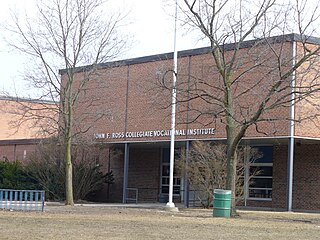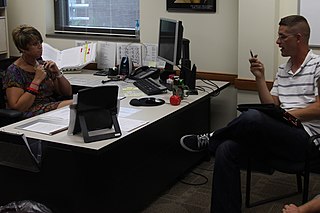
Vocational education is education that prepares people for a skilled craft as an artisan, trade as a tradesperson, or work as a technician. Vocational education can also be seen as that type of education given to an individual to prepare that individual to be gainfully employed or self employed with requisite skill. Vocational education is known by a variety of names, depending on the country concerned, including career and technical education, or acronyms such as TVET and TAFE.
An internship is a period of work experience offered by an organization for a limited period of time. Once confined to medical graduates, internship is used practice for a wide range of placements in businesses, non-profit organizations and government agencies. They are typically undertaken by students and graduates looking to gain relevant skills and experience in a particular field. Employers benefit from these placements because they often recruit employees from their best interns, who have known capabilities, thus saving time and money in the long run. Internships are usually arranged by third-party organizations that recruit interns on behalf of industry groups. Rules vary from country to country about when interns should be regarded as employees. The system can be open to exploitation by unscrupulous employers.

In education, a curriculum is broadly defined as the totality of student experiences that occur in the educational process. The term often refers specifically to a planned sequence of instruction, or to a view of the student's experiences in terms of the educator's or school's instructional goals. A curriculum may incorporate the planned interaction of pupils with instructional content, materials, resources, and processes for evaluating the attainment of educational objectives. Curricula are split into several categories: the explicit, the implicit, the excluded, and the extracurricular.

A comprehensive school is a secondary school for pupils aged 11–16 or 11–18, that does not select its intake on the basis of academic achievement or aptitude, in contrast to a selective school system where admission is restricted on the basis of selection criteria, usually academic performance. The term is commonly used in relation to England and Wales, where comprehensive schools were introduced as state schools on an experimental basis in the 1940s and became more widespread from 1965.
A national qualifications framework (NQF) is a formal system describing qualifications. 47 countries participating in the Bologna Process are committed to producing a national qualifications framework. Other countries not part of this process also have national qualifications frameworks.

Medical education in Australia includes the educational activities involved in the initial and ongoing training of Medical Practitioners. In Australia, medical education begins in Medical School; upon graduation it is followed by a period of pre-vocational training including Internship and Residency; thereafter, enrolment into a specialist-vocational training program as a Registrar eventually leads to fellowship qualification and recognition as a fully qualified Specialist Medical Practitioner. Medical education in Australia is facilitated by Medical Schools and the Medical Specialty Colleges, and is regulated by the Australian Medical Council (AMC) and Australian Health Practitioner Regulation Agency (AHPRA) of which includes the Medical Board of Australia where medical practitioners are registered nationally.
The Victorian Certificate of Applied Learning (VCAL) is a 'hands-on' program for students in Years 10, 11, and 12 and is a credential awarded to secondary school students who successfully complete year 11 and 12 in the Australian State of Victoria since 2002. The VCAL gives students practical work-related experience, as well as literacy and numeracy skills and the opportunity to build personal skills that are important for life and work.
Following independence from the Soviet Union, a major economic depression cut "public financing" for education in Kazakhstan, "which dropped from 6% of gross domestic product in 1991 to about 3% in 1994, before rising to 4% in 1999. Elementary- and secondary-school teachers remain badly underpaid; in 1993 more than 30,000 teachers left education, many of them to seek more lucrative employment.
Education in the Philippines is compulsory at the basic education level, composed of kindergarten, elementary school, junior high school, and senior high school. The educational system is managed by three government agencies by level of education: the Department of Education (DepEd) for basic education; the Commission on Higher Education (CHED) for higher education; and the Technical Education and Skills Development Authority (TESDA) for technical and vocational education. Public education is funded by the national government.

An academic certificate is a document that certifies that a person has received specific education or has passed a test or series of tests.

Career counseling is a type of advice-giving and support provided by career counselors to their clients, to help the clients manage their journey through life, learning and work changes (career). This includes career exploration, making career choices, managing career changes, lifelong career development and dealing with other career-related issues. There is no agreed definition of the role of a career or employment counsellor worldwide, mainly due to conceptual, cultural and linguistic differences. However, the terminology of 'career counseling' typically denotes a professional intervention which is conducted either one-on-one or in a small group. Career counseling is related to other types of counseling. What unites all types of professional counseling is the role of practitioners, who combine giving advice on their topic of expertise with counseling techniques that support clients in making complex decisions and facing difficult situations.

Don College is a government comprehensive senior secondary school located in Devonport on the north-western coast of Tasmania. "The Don", as it is commonly known to residents of Devonport, is situated by the Don River and enjoys views over the river and surrounding forest reserve. The college caters for approximately 800 students in Years 11 and 12 and is administered by the Tasmanian Department of Education. Don College attracts students from Penguin and Deloraine.
Career Pathways is a workforce development strategy used in the United States to support workers’ transitions from education into and through the workforce. This strategy has been adopted at the federal, state and local levels in order to increase education, training and learning opportunities for America’s current and emerging workforce.
Tasmania Tomorrow is a Tasmanian-government initiative which aims to improve the post-secondary education experience of Tasmanians. The initiative commenced 1 January 2009, and includes restructuring Senior Secondary Colleges and TAFE Tasmania. It was anticipated that the restructuring would be complete by the start of the 2011 school year.
The Rhode Island Department of Education (RIDE) is a state agency in Rhode Island that oversees the elementary and secondary education system from pre-Kindergarten through twelfth grade. It is headquartered in Providence. RIDE works closely with the Rhode Island Office of the Postsecondary Commissioner (RIOPC), the agency charged with overseeing higher education. Together, RIDE and RIOPC aim to provide an aligned, cohesive, and comprehensive education for all students.
The Department of Education is a ministerial department of the Queensland Government responsible for the administration and quality of education in Queensland, Australia. The department is composed of two separate portfolios, Education Queensland and Early Childhood Education and Care (ECEC). The department also encompasses the Queensland Curriculum and Assessment Authority, a separate statutory authority responsible for creating syllabuses, curriculums, and assessment.

A comprehensive school, or simply a comprehensive, typically describes a secondary school for pupils aged approximately 11-16 or 11–18, that does not select its intake on the basis of academic achievement or aptitude, in contrast to a selective school system where admission is restricted on the basis of selection criteria, usually academic performance. In England and Wales comprehensive schools were introduced as state schools on an experimental basis in the 1940s and became more widespread from 1965. They may be part of a local education authority or be a self governing academy or part of a multi-academy trust.
A high school diploma is a diploma awarded upon graduation of high school. A high school diploma is awarded after completion of courses of studies lasting four years, typically from grade 9 to grade 12. It is the school leaving qualification in the United States and Canada.
ACT, Inc. is an American 501(c)(3) nonprofit organization, primarily known for the ACT, a standardized test designed to assess high school students' academic achievement and college readiness. For the U.S. high school graduating class of 2019, 52 percent of graduates had taken the ACT test; the more than 1.78 million students included virtually all high school graduates in 17 states.
School organizational models are methods of structuring the curriculum, functions, and facilities for schools, colleges, and universities. The organizing of teaching and learning has been structured since the first educational institutions were established. With greater specialization and expertise in a particular field of knowledge, and a gathering of like-minded individuals, instructors clustered into specialized groups, schools, and eventually departments within larger institutions. This structure spread rapidly during the 19th and 20th centuries with factory model schools and their "assembly-line" method of standardized curriculum and instructional methods. Beginning with the progressive educational movement in the early-mid 20th century, and again with similar trends in the late 20th and early 21st century, alternative models structured towards deeper learning, higher retention, and 21st century skills developed. The organizational models of schools fall into several main categories, including: departmental, integrative, project-based, academy, small learning communities, and school-within-a-school.